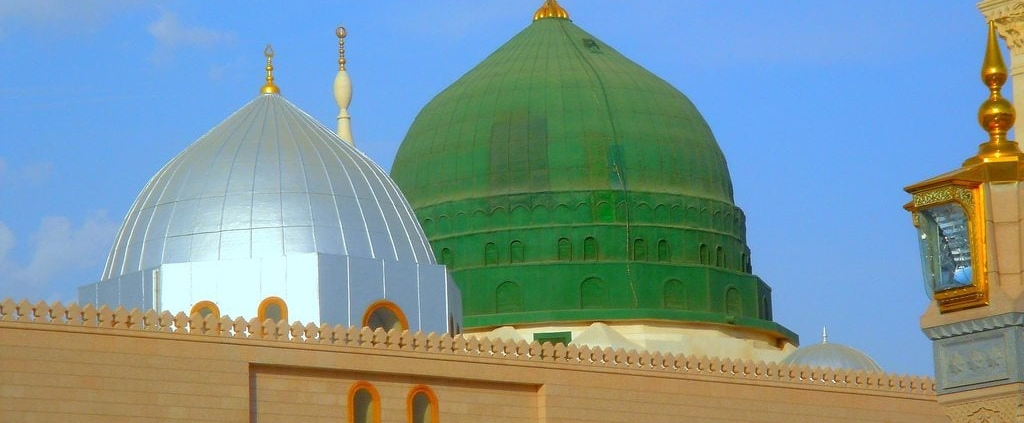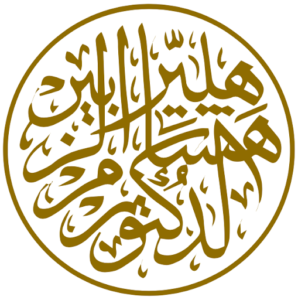The Etiquette (Adab) of the Visitation (Ziyara) of the Prophet ﷺ – Dr. Hisham A. Hellyer
The Sacred Signs of God
The sages and scholars of this religion have agreed that veneration for the sacred signs (sha’ir) of God is from the virtues of the heart – likewise, lack of proper etiquette (adab) with those signs is evidence of an unhealthy heart. Allah says in His Book: “If someone venerates the sacred signs of Allah, this is truly a sign of piety in the heart”. (Qur’an 22:32)
The scholars note that from among these signs are the Prophet Muhammad ﷺ, the house of God (the Ka’aba in al-Makka al-Mukarrama), the Divine Word (the Qur’an), the five daily prayers (al-salawat al-khams), and the month of Ramadan. Without the Prophet, we would know nothing of the reality of any of these things. There are many evidences to note in this regard from the Qur’an and the Sunna – for this tract, it suffices to present this sacred tradition (hadith qudsi) which is mentioned in the compendium of authentic narrations, compiled by Imam al-Bukhari: The Prophet ﷺ said, “Verily Allah, the Most High has said: ‘Whosoever shows enmity to a friend (wali) of Mine, then I have declared war against him. And My servant does not draw near to Me with anything more loved to Me than the religious duties I have obligated upon him. And My servant continues to draw near to me with supererogatory (nafil) deeds until I Love him. When I Love him, I am his hearing with which he hears, and his sight with which he sees, and his hand with which he strikes, and his foot with which he walks. Were he to ask [something] of Me, I would surely give it to him; and were he to seek refuge with Me, I would surely grant him refuge.’ ”
The Excellence of the Prophet ﷺ
It is the only via the Prophet ﷺ that we know what those religious duties are. It is only via the Prophet ﷺ that we know what the supererogatory deeds are. He is, thus, the means by which we are given the knowledge to draw near to God.
He is the ‘Perfect Human’ (al-insan al-kamil), which also is the title of a famous contemporary work by the traditionist of the Hijaz (al-muḥaddith al-hijaz), the shaykh of our shaykhs, Sayyid Muhammad b. Alawi al-Maliki, may God have mercy upon him. The Prophet ﷺ is the Messenger of Mercy (raḥma), whom God sent as a mercy to all created things, which is mentioned in the words of God: “And We have not sent you except as a mercy to all the worlds”(21:107).
And this same attribute of mercy is the attribute of God that is mentioned time and again in this religion, whether it be in the sacred narrations, or in the word of God. Indeed, consider that the basmala (the saying of bismillah al-rahman al-rahim), which opens every cycle of prayer, and is recommended before every action, includes not one, but two attributes relating to mercy (raḥma): al-Rahman, al-Rahim.
It is for this reason and many others that the scholars said that out of all of the sacred signs of God, the Prophet ﷺ is the most sacred indeed – and why the visitation to him is so recommended. The below includes some of the most pertinent recommendations included therein – and there will be many others, but one hopes this will suffice for the ease of memorising and remembering, particularly for those for whom the visitation to Madina is their first time.
The Visitation of the Prophet ﷺ – (Be Merciful to One Another)
Our teachers reminded us, therefore, that in the event we were considering the visitation (ziyara) of the Prophet ﷺ, we should do so in a way that is befitting of the occasion. His essence is mercy – our essence, at all times, but particularly as we embark from our homes to pursue the visitation, should be a complete emulation of that sacred attribute. Our mercy with our families, our friends, those that we know and those that we do not – it is mercy that we should focus upon in our character. If we are genuine in our desire to follow his practise (Sunna), then we should know that this is his Sunna: being a mercy to all the worlds.
As one approaches al-Madina al-Munawwara (the Illuminated City), one should remember – they are visiting the city in which the mercy to the worlds lived, taught, and passed from this world. When one visits the city, one should not be surprised if they feel this overwhelming feeling of serenity (sakina) within it, and this subtle sweetness (jamal): rather, this is entirely natural, considering who is buried therein. There is an awesome-like (jalal) nature to Makka, which cannot be mistaken – and there is a subtle sweetness-like nature (jamal) to Madina, which cannot be mistaken.
Imam Nawawi, one of the foremost authorities of the Shafi’i rite (madhhab), in his commentary on Sahih Muslim, one of the most authentic compilations of Prophetic narrations (ahadith), said:
“The scholars have differed regarding the meaning of the above exception in the same way that they have differed concerning Makka and Madina: which of the two is better? The way of Shafi`i and the vast majority of the scholars is that Makka is better than Madina and that the mosque in Mecca is better than the mosque in Madina. The opposite is true for Malik and a group of scholars”.
So, even though we may follow the opinion that Makka is better, the opinion that Madina is better is clearly of great merit, and well respected, as Imam Malik and others declared it as such.
Indeed, many of our scholars declared that irrespective of the above, the site of the Prophet’s tomb is the holiest place on earth – holier than that of the Ka’aba. Some even compared the nobleness of its location to the nobility of the Throne itself.
And Allah knows best.
The Importance of the Visitation
The visitation, according to most of our scholars, is legally recommended (mandūb); some of our scholars emphasised it so much, that one should be concerned about not making that visit, due to the immense benefit that comes from the visitation. Indeed, the Prophet is narrated as having said:
“Whoever visits my grave, my intercession becomes obligatory for him.”
“Whoever visits me and has no other motive, has a right over me that I intercede on his behalf.”
“Whoever visits me after my death is like he who had visited me during my life.”
“Whoever undertakes a journey specially to visit me, will be my neighbour on the Day of Judgement.”
Be sure that when you visit the Prophet ﷺ, you do not fall into poor etiquette by saying, ‘I am visiting the tomb of the Prophet’ – for you must be aware you are the guest of the Prophet ﷺ, who is aware of you and responds to you. And thus, show it the due respect.
Likewise, be sure to formulate your intention properly – that you intend to visit the Prophet ﷺ, visiting his mosque, praying therein, and thereby drawing closer to the Divine.
Litanies and Practices
The litany (dhikr) that is recommended once your intention has been made is the sending of blessings and prayers (salawat) upon the Prophet ﷺ – any one that you prefer.
Ensure you are clean, fully washed (with a complete bath (ghusl)) wearing good clothes, perfumed, as you would when visiting an honoured dignitary. This should preferably done before you enter Madina, or immediately upon your arrival and before your visit to the Prophet ﷺ.
When you enter Madina, continue your sending prayers upon Prophet ﷺ, and say the following supplication:
اَللهُمَّ هَذَا حَرَمُ نَبِيِّكَ فَاجْعَلْهُ وِقَايَةً لِيْ مِنَ النَّارِ وَآمِنَّا مِنْ الْعَذَابِ وَسُوْءِ الْحِسَابِ.
Allāhumma hādhā ḥaramu nabiyyika faj’alhu wiqāyatan lī mina n-nāri wa amānan mina l-‘adhābi wa sū’a l-ḥisāb
“O Allah, this is the Sacred Precinct of Your Prophet, so make it a protection for me from the Fire and a security from punishment and a bad reckoning.”
The Visiting of the Mosque
The resting place of the father of the Prophet ﷺ, Sayyidina ‘Abdallah b. Abd al-Muttalib (may Allah be pleased with him) is to be found within the enclosure of Masjid al-Nabawi; there is a space near to the Prophet ﷺ that is specified for the resting place of the Prophet Jesus, Sayyidina ‘Isa b. Maryam (upon whom be peace); the original site of the house of Sayyidina Ali b. Abi Talib (may Allah be pleased with him), may God pleased with him, and Sayyidatuna Fatima (may Allah be pleased with her) is to be found in where the mosque now stands; the Mihrab al-Tahajjud, where the Prophet ﷺ would pray the night vigil (tahajjud) prayer, is in the same precinct; and the ‘Bench’ of the ‘People of the Bench’, who were particularly renowned for their piety (Ahl al-Suffa) is in this same precinct.
With a full awareness, one should proceed to the Prophet ﷺ, reciting salawat, and giving some charity. Recall and remember that you are visiting the Beloved of God, al-Habib, and that you have been chosen and selected to do so by the grace of God.
It is preferable (mandūb) to enter the mosque from the door of Jibril (Bab Jibril) because that was the practice of the Prophet ﷺ – but you may enter through any door.
Following your entrance into the Mosque, ensure you follow the regular etiquette of entering the mosque:
- Enter with the right foot
- Recite the supplication: بِسْمِ اللهِ، اللَّهُمَّ صَلِّ عَلَى مُحَمَّدٍ. اللَّهُمَّ اغْفِرْ لِي وَافْتَحْ لِي أَبْوَابَ رَحْمَتِك
Bismi-llāh, Allāhumma ṣalli alā Muhammad. Allāhumma-ghfir lī wa-ftaḥ lī abwāba raḥmatik.
In the name of Allah, send blessings upon Muhammad ﷺ. O Allah, open for me the doors of Your Bounty. - Make the intention for spiritual retreat (i’tikaf)
It was the practice of many of the righteous that they would go straight to the Prophet ﷺ, and send him greetings, before anything else, including before they would pray two units (raka’tayn) of prayer to greet the mosque (tahiyyat al-masjid). One should focus solely on the purpose of the visit, which is to greet and visit the Prophet ﷺ. However, if the area in front the Prophet ﷺ is busy, then pray 2 units of prayer as noted below at the Rawda, and then continue to the Prophet ﷺ.
One should proceed to the area of the Rawda, which is in the centre of the mosque, marked by a light green floral carpet. The Prophet ﷺ said of this place: ”The area between my house and my minbar is one of the meadows of Paradise, and my minbar is on my pond (al-Hawd)”. Many of our scholars said that this means, literally, that this area is from Paradise.
In the Rawda, one should pray two units of prayer for greeting the mosque – it has been narrated it is preferable that sura al-Kafirun and sura al-Ikhlas are best to read in the first and second raka’ats respectively. If one cannot do so in the Rawda itself, then pray as close as you can. Remember that it is your intention that is rewarded.
Following this, recall the immense blessing that God has bestowed upon you for this incredible opportunity, as a guest of the Prophet ﷺ. Supplicate to God tremendously – this is one of the most special places on this earth.
You will then eventually exit the mosque from the south, near Bab al-Salam – and in so doing, you will be passing in front of the Prophet ﷺ. Remember: as you walk through this area, you are walking on the ground that was walked upon by the Prophet ﷺ, by his family, by his companions, by his followers, by their followers, by the scholars and sages of this umma.
Read salawat in abundance and be aware you are approaching the physical nearness of the Final Messenger of God; be humble, be aware of your faults, and be hopeful of attaining forgiveness.
The Prophet ﷺ, Sayyidina Abu Bakr (may Allah be pleased with him) and Sayyidina Umar (may Allah be pleased with him) are all buried in the middle enclosure that you can see among three enclosures. Stand a little away from the enclosure, facing it, with your back towards the Qibla, and turn slightly left so your face is facing directly to the Prophet ﷺ, who is directly behind the first hole of the middle enclosure that you will be able to see. Invoke prayers and send blessings upon the Prophet ﷺ, in abundance, and request what you will via his intercession (wasila).
And after you have done so, give the Prophet ﷺ your greetings of peace, the minimum of which is:
اَلسَّلَامُ عَلَيْكَ يَا رَسُوْلَ اللهِ
As-salāmu ‘alayka yā rasūlAllāh.
Peace be upon you, O Messenger of Allah.
Do not do so loudly, without decorum – do so with dignity and humility, envisioning the Prophet ﷺ in front of you. Indeed, keeping your voice low at all times in the presence of the Prophet ﷺ is warranted, in due respect of him.
Then, recite more salawat upon the Prophet ﷺ;
repeat the testification of faith;
invoke God for His forgiveness (istighfar);
thank the Prophet ﷺ;
and then do not neglect asking the Prophet for his intercession:
يَا رَسُوْلَ اللهِ، أَسْأَلُكَ الشَّفَاعَةَ وَأَتَوَسَّلُ بِكَ إِلَى اللهِ أَنْ أَمُوْتَ مُسْلِمَاً عَلَى مِلَّتِكَ وَسُنَّتِكَ
Yā rasūla llāh as’aluka ash-shafā’ata wa atawassalu bika ila llāhi ‘an ‘amūta Musliman ‘ala millatika wa sunnatik.
O Rasul Allah! I request your intercession, and I ask Allah, through you, to enable me to die on your religion and your Sunnah.
If you do not know the supplication by heart, do so in whatever words you choose. Do not neglect sending greetings to Sayyidina Abu Bakr (may Allah be pleased with him) and Sayyidina Umar (may Allah be pleased with him) facing them – which means stepping a little to the right, twice – and then you may return to facing the Prophet ﷺ to make more supplications, before you leave the mosque. Do not give the resting place of the Prophet your back, at any time.
As you leave the mosque, you’ll be facing Janna al-Baqi’, where many of the righteous are buried – it is appropriate to send them the gift of the reward of reciting Sura al-Fatiha by reading it with that intention.
Farewell to Madina
One hopes that one makes the best use of their time in Madina while they are there. Spend your time well, plan it well, use it well. As you pass in front of the mosque of the Prophet ﷺ, ensure you always give him greetings.
Before you leave Madina, ensure you visit him ﷺ one last time before departure. Shaykh Abdal Qadir al-Jilani recommended we supplicate: “O Allah, don’t make this the last of my visit to the grave of Your Prophet, and if you cause me to die, then make me die loving him and his Sunna. Amin, O most merciful of the merciful!”
Our teachers said: leave your heart and soul in those blessed places, and only let your body take the return trip. May God bless us all with the secrets of the ziyara.
Shaykh Dr Hisham A. Hellyer
Born to an English father and to an Egyptian mother of ʿAbbāsī-Sudanese & Ḥasanī-Moroccan heritage, Shaykh Dr Hisham A. Hellyer was raised between England and different parts of the Arab world, before becoming educated at Sheffield and Warwick universities to post-doctoral levels in law and the social sciences.
Shaykh Hisham studied – and studies – the Islamic tradition in the UK, Egypt, South Africa, the Gambia, Malaysia, Singapore, and elsewhere, keeping the company of traditionally trained scholars. These included the contemporary polymath, Tan Sri Professor Sayyid M. Naquib al-Attas, who mentored him in Malaysia, and Shaykh Seraj Hendricks, the South African sage and khalifa of the Makkan exemplar, Sayyid Muhammad b. Alawi al-Maliki.
This was alongside Dr Hellyer’s research and academic career in institutions including the Carnegie Endowment for International Peace, the Brookings Institution, the University of Cambridge’s Centre for Islamic Studies, Harvard University, and the Royal Institute (RUSI). His published books include “A Sublime Way: the Sufi Path of the Makkan Sages”, “A Revolution Undone: Egypt’s Road Beyond Revolt”, “The Islamic Tradition and the Human Rights Discourse”, and “Muslims of Europe: the ‘Other’ Europeans”.
A member of the Council of the British Board of Scholars and Imams, he was appointed as the only Senior Scholar of Azzawia Institute in South Africa by Shaykh Seraj Hendricks, and the first professorial fellow in Islamic Studies at Cambridge Muslim College of Shaykh Abdal Hakim Murad/Dr. Timothy J. Winter. In 2020, he was selected as a Fellow of the Royal Society of Arts in recognition of achievements to social change. @hahellyer
Further Resources:
Information on the Sites of the Holy City of Madina (pdf) – ‘Madinah Ziyarah Guide‘
Visitation of the Prophet
Advice from Habib Umar
The Etiquette of the Ziyara (Dar al-Ifta al-Misriyya)
Selected Further Reading:
Ihya ‘Ulum al-Din, by Imam Abu Hamid al-Ghazali
al-Ghunya li talibi Tariq al-Haqq, by Shaykh Abdal Qadir al-Jilani
Al-Arba’in, by Imam al-Nawawi
al-Majmu` Sharh al-Muhadhdhab, by Imam al-Nawawi
al-Idah fi Manasik al-Hajj, by Imam al-Nawawi


